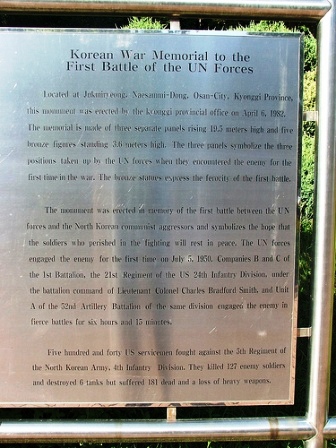One the west side of Highway 1.
Statue
The monument consists of three stone panels, which represent the three positions held by the task force, and a bronze statue of five soldiers engaging the enemy. It overlooks a paved court where a ceremony commemorating the battle takes place annually. The monument was erected by the South Korean government in 1982 and features the flags of the countries that fought with the United Nations in the war.
Lt. Colonel Charles B. Smith commanded the 21st Infantry Regiment under orders to head north and stop the North Koreans as far from Pusan as possible. Task Force Smith consisted of his undermanned battalion of 406 men and 134 men of A battery, and the 52nd Field Artillery was air lifted later. On the morning of July 5, 1950, North Korean tanks approached followed by a convoy of two regiments. They were taken by surprise and Smith and his men held out for three hours before they ran low on ammunition. They withdrew to Pyongtaek, picking up stragglers along the way. The result of the battle was that the North Koreans were delayed by about seven hours at the cost of 20 killed, 130 wounded or missing, and 36 captured. However, it did allow other units of the 24th Division to set up another delaying position at Pyongtaek.
Korean War Memorial to the First Battle of the UN Forces
Located at Jukiryeong, Naesammi-Dong, Osan-City, Kyonggi Province, this monument was erected by the kyonggi provincial office on April 6, 1982, The memorial is made of three separate panels rising 19.5 meters high and five bronze figures standing 3.6 meters hight. The three panels symbolize the three positions taken up by the UN forces when they encountered the enemy for the first time in the war. The bronze statues express the ferocity of the first battle.
The Monument was erected in memory of the first battle between the UN forces and the North Korean communist aggressors and symbolizes the hope that the soldiers who perished in the fighting will rest in peace. The UN forces engaged the enemy for the first time on July 5, 1950. Companies B and C of the 1st Battalion, the 21st Regiment of the US 24th Infantry Division, under the battalion command of Lieutenant Colonel Charles Bradford Smith, and Unit A of the 52nd Artillery Battalion of the same division engaged the enemy in fierce battles for six hours and 15 minutes.
Five hundred and forty US servicemen fought against the 5th Regiment of the North Korean Army, 4th Infantry Division. They killed 127 enemy soldiers and destroyed 6 tanks but suffered 181 dead and a loss of heavy weapons.


